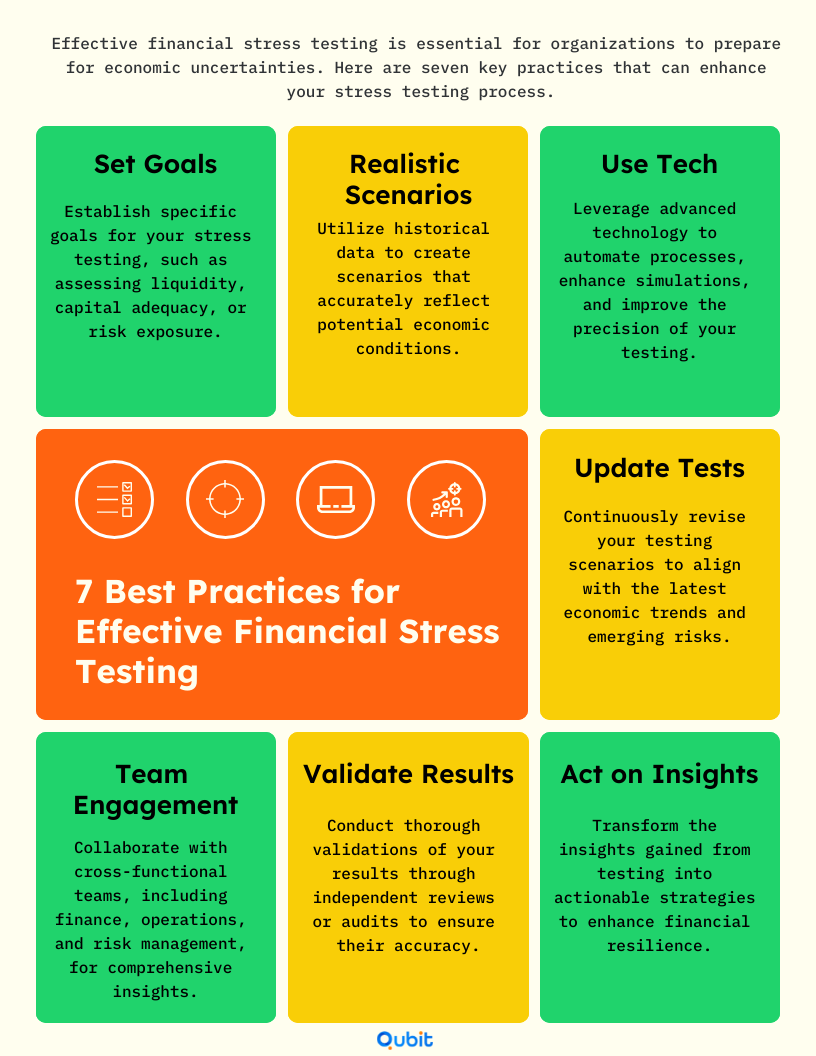Building a financial model is only the beginning; ensuring its resilience is where the real challenge lies. Financial stress testing is a critical process that evaluates how your model performs under adverse conditions, helping you anticipate risks and prepare for uncertainties. Whether you're a startup or an established business, stress testing your financial model can reveal vulnerabilities that might otherwise go unnoticed.
Choosing the best financial forecasting software for startups enhances the accuracy of projections, a critical step before conducting stress tests to ensure resilience. With the right tools and techniques, you can simulate scenarios that test your model's limits and ensure it remains robust across varying market conditions. Let’s dive into the essentials of stress testing and explore how it can safeguard your financial strategy.
Why Stress Testing in Financial Models is Important
Stress testing financial models is a critical step in ensuring their accuracy and reliability, especially when they are handed off to stakeholders. By rigorously examining formula logic and assumptions, potential errors can be identified and corrected, safeguarding the integrity of the model.
Why Stress Testing Matters
Financial stress testing goes beyond simple validation; it evaluates how models perform under various scenarios. This process helps uncover hidden issues in formula calculations, such as discrepancies in balance sheet totals, retained earnings, or cash flow alignment. For example, ensuring that the ending cash balance in the cash flow statement matches the balance sheet is essential for maintaining consistency.
Key Areas to Test
- Formula Logic
Errors in formulas can lead to cascading inaccuracies throughout the model. Systematic checks ensure that calculations for retained earnings, net income, and dividends are accurate. - Assumption Variability
Testing assumptions under different scenarios reveals how sensitive the model is to changes. For instance, altering revenue growth rates or expense forecasts can highlight vulnerabilities that might otherwise go unnoticed. - Balance Sheet Consistency
Ensuring that balance sheet components add up correctly is another vital step.
Enhancing Model Reliability
A well-tested financial model not only improves internal decision-making but also builds confidence among stakeholders. Opportunities like the Excel Crash Course can help refine Excel skills, making stress testing more efficient and thorough.
Financial professionals who emphasize stress testing can create reliable, resilient models, leading to stronger stakeholder collaboration and improved results.
Proven Methodologies for Financial Stress Testing
Understanding how financial models respond to adverse conditions is critical for risk management. Financial stress testing employs various methodologies to assess the resilience of models under different scenarios. Each approach offers unique insights into risk exposure and operational vulnerabilities, enabling organizations to prepare for uncertainties effectively.
1. Scenario Analysis: Testing Hypothetical Conditions
Scenario analysis techniques provide insights into potential risks, setting the stage for applying stress testing methods. This method evaluates how a model performs under hypothetical severe conditions, such as economic downturns or market disruptions.
Running simulations of severe but possible events allows organizations to spot vulnerabilities. With these insights, they can build stronger risk management plans.
2. Sensitivity Analysis: Examining Variable Impacts
Sensitivity analysis focuses on the effects of individual variable changes on a financial model. By altering one factor at a time—such as interest rates or inflation—this approach highlights the specific elements that have the most significant impact on performance. It’s particularly useful for pinpointing areas of concern and refining model parameters to enhance accuracy.
3. Reverse Stress Testing: Defining Failure Points
Reverse stress testing flips the traditional approach by identifying conditions that would lead to model failure. Instead of starting with plausible scenarios, this method works backward to determine the thresholds at which a financial system becomes unsustainable. This proactive approach helps organizations understand their limits and prioritize safeguards against catastrophic risks.
Each methodology serves a distinct purpose, offering a comprehensive view of a model’s resilience. While scenario analysis prepares for external disruptions, sensitivity analysis refines internal variables, and reverse stress testing ensures preparedness for worst-case outcomes. Together, these techniques form a robust framework for financial stress testing.
These methodologies empower businesses to refine their risk management processes and develop models that can withstand volatility.
Best Practices for Effective Financial Stress Testing
Financial stress testing is a critical tool for assessing the resilience of an organization under adverse conditions. To ensure the process delivers credible and actionable results, adopting proven best practices is essential. Below are seven key strategies that enhance the effectiveness of financial stress testing.

1. Define Clear Objectives
A well-defined purpose sets the foundation for a successful financial stress testing process. Whether the goal is to evaluate liquidity, capital adequacy, or operational risks, clarity ensures the testing aligns with organizational priorities. This step also helps stakeholders understand the relevance of the outcomes.
2. Focus on Realistic Scenarios
Selecting scenarios that reflect plausible economic or market conditions is crucial. Unrealistic or overly optimistic assumptions can undermine the reliability of the results. For example, incorporating historical data from past financial crises can provide valuable insights into potential vulnerabilities.
3. Incorporate Advanced Technology
Modern tools and software streamline the stress testing process, enabling more accurate simulations and faster analysis. Solutions like Deluxe Payment Exchange+ can enhance operational efficiency by eliminating manual processes and offering secure payment options. Integrating such technologies into financial workflows ensures better preparedness for stress scenarios.
4. Regularly Update Testing Scenarios
Economic conditions and market dynamics evolve rapidly. Regularly revisiting and updating stress testing scenarios ensures they remain relevant and reflect current risks. This practice helps organizations stay ahead of emerging threats.
5. Engage Cross-Functional Teams
Effective stress testing requires collaboration across departments, including finance, risk management, and operations. Diverse perspectives enrich the process, ensuring comprehensive coverage of potential risks.
6. Validate Results Thoroughly
Validation is essential to confirm the accuracy and reliability of stress testing outcomes. Using independent reviews or external audits can strengthen confidence in the results and highlight areas for improvement.
7. Translate Insights into Action
The ultimate goal of financial stress testing is to drive actionable strategies. Organizations must use the insights gained to refine risk management frameworks, enhance decision-making, and strengthen overall resilience.
Implementing these best practices helps businesses conduct financial stress tests that provide valuable insights, ensuring long-term stability and growth
Decoding Financial Model Stress Testing: Trends and Challenges
Stress testing is a cornerstone of good financial modeling. It shows if your predictions can handle different conditions and builds confidence among stakeholders.
Validation Checks:
- Systematically review assumptions, inputs, and outputs.
- Cross-check with historical data or industry benchmarks to catch errors early.
A layered approach makes stress tests even stronger. This means using different tests like scenario analysis, sensitivity testing, and extreme case simulations. Each test looks at the model from a unique angle, which reinforces its overall accuracy.
Regular stress testing helps validate your assumptions and uncovers hidden risks. With a clear, structured process, your financial models become both accurate and resilient, ready to face uncertainty head-on.
Practical Example of Stress Testing Your Financial Model
Stress testing financial models can uncover hidden vulnerabilities that might otherwise go unnoticed. Imagine a scenario where a company forecasts its revenue growth based on market expansion assumptions. By isolating specific variables, such as customer acquisition costs or regional sales performance, you can test how changes in these assumptions impact the overall model. This targeted approach often reveals discrepancies or errors that could compromise decision-making.
For instance, adjusting the customer acquisition cost in a model might expose an unrealistic dependency on marketing spend. If the model assumes a linear relationship between marketing expenses and revenue growth, stress testing can highlight whether this assumption holds true across different spending levels. Such insights simplify error detection, enabling you to refine the model for greater accuracy.
To make this process even more efficient, AI-powered financial modeling tools streamline projections, making it easier to incorporate stress testing for automated optimization. These tools not only enhance model resilience but also ensure that adjustments to individual line items are precise and actionable.
For those looking to implement stress testing, a free template is available here. This resource provides a structured framework to test your financial assumptions effectively.
Determining the Critical Focus Areas for Your Stress Test
Start by choosing scenarios that are both extreme and believable. This is key for spotting weaknesses in your financial plan.
Realistic Scenarios:
- Think about events like geopolitical conflicts or global supply chain disruptions.
- Use recent examples to guide your planning.
Stress tests should mirror real-world challenges. For instance, the changes seen in the 2020s show that external factors now play a bigger role. Focusing on these areas helps you uncover weak points and improve your backup plans.
Global Economic Trends:
- Keep an eye on shifting market dynamics.
- Understand how interconnected economies affect your business.
Simulating extreme yet plausible scenarios isn't just theory. It's a proactive step to protect your financial stability. With the right focus areas, your stress test becomes a powerful tool against uncertainty.
Ready to Plan Your Stress Test?
Preparing for financial stress testing requires a structured approach to ensure meaningful outcomes. Start by identifying key financial variables and scenarios that could impact your business. These might include market volatility, operational disruptions, or unexpected changes in consumer behavior. Once you’ve pinpointed these factors, design stress tests that simulate their potential effects on your financial model.
The insights gained from finance stress testing should not remain isolated. Instead, integrate these findings into your broader strategic planning to enhance long-term resilience. For example, if a stress test reveals vulnerabilities in cash flow during a downturn, consider revising your financial projections or exploring alternative revenue streams. Knowing how to create a financial model for investors lays the foundation for attracting investors, and stress testing ensures these models remain resilient under varying market conditions.
Ultimately, stress testing is more than a diagnostic tool—it’s a proactive measure to safeguard your financial stability. At Qubit Capital, we specialize in helping businesses implement effective stress testing frameworks. Contact us today to explore how we can support your financial planning and resilience strategies.
Conclusion
Building resilient financial models requires a proactive approach, and stress testing is a cornerstone of this process. Throughout this blog, we’ve explored strategies to identify vulnerabilities, assess risks, and ensure your financial planning can withstand unexpected challenges. By implementing these insights, you can create models that not only adapt to change but also inspire confidence among stakeholders.
Comprehensive stress testing is more than a safeguard—it's an essential practice for sustainable growth. It reinforces the importance of preparing for uncertainties while maintaining a strong foundation for decision-making.
If you're ready to showcase your robust financial planning, let our team at Qubit Capital help you build an impressive financial model. Check out our Financial Model Creation service to turn your strategies into clear, compelling projections.
Key Takeaways
- Regular stress testing is essential to build resilient financial models.
- Advanced methodologies like scenario, sensitivity, and reverse stress testing offer deep risk insights.
- Realistic scenarios and systematic error checks are critical for accurate models.
- Continuous review and integration of findings enhance financial planning.
- Leveraging expert services at Qubit Capital can elevate your financial strategy.


 Back
Back



